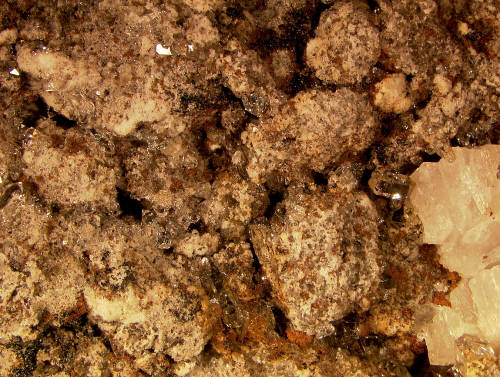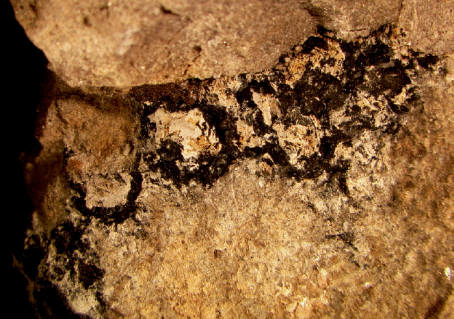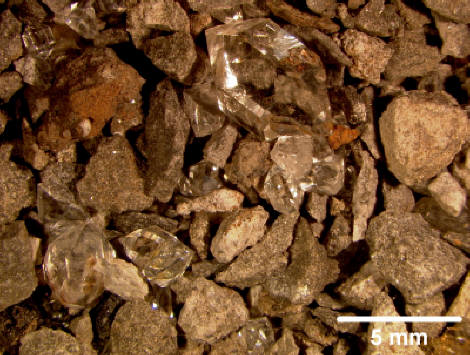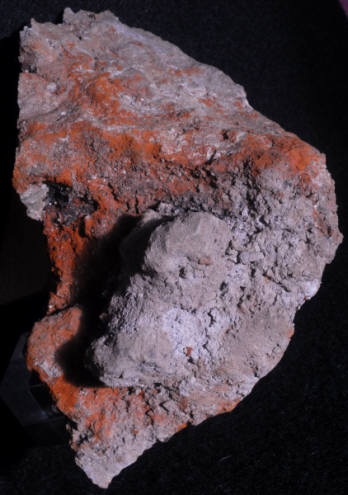This site was last updated on May, 2011
Definitions and Scope: The theory that there are two sources of "mud" is controversial
The best website on "Herkimer Diamonds"
Almost all the pockets containing clusters of Herkimer diamonds come with a black carbon material, most appropriately called hydrocarbon, along with clay (mud). Even some of the small "vugs" that have only one or two crystals may be packed with the black hydrocarbon. But there are pockets that contain clay/mud and little hydrocarbon. Sometimes that clay/mud is the common brown. But occassionally it is white, yellow, red/orange or black. What is proposed here is that some of the clay that is found in pockets was formed during the same time as other minerals in these pockets.
Please help with picture donations!
Other Minerals - Clay and Pocket Mud
A public service project always open to input from the community interested in Herkimer diamonds.
In the picture below (Fonda, NY - DA, 2008) the clay is coating second phase dolomite. The clay is often white or cream - different from the re-worked pocked mud which has a brownish color. In both of these pictures it is not easy to see the clay as something significant and probably moving into the rock at the end of when the carbon material came (you can see the black carbon in the above photo). This clay is important in terms of developing a theory about Herkimer diamonds.
Perhaps, as collectors become more aware, they will pay closer attention to the occurence of clay and the black (brown) carbon material. Collect samples, take photos, and help to expand our knowledge about these wonderful mineral deposits.
Web page author - W. David Hoisington, Ph.D.
Below are a two photos (Fonda, DA - 2008) that show the original clay, and how it look different from mud. The first, on the bottom left, is accompanied by black carbon material in a string of small vugs in solid rock that were protected from ground water.
The photo on the left was donated by Mike Eggleston (2008) and is of a skeletal crystal from Treasure Mt. The inner skelton structure doesn't show well in this photo but can be seen in the lower left and bottom center. But the photo is placed here, as opposed to being on the skeletal page, because it is an excellent picture of the white clay coating (arrow points) the crystal faces of the "skeleton" which is inside the crystal. As is noted on the skeltal page, clay is commonly found in the pockets containing these crystals.
What is in the Bottom of a Pocket?
Sometimes people write to me and ask me what kinds of "junk specimens" would be helpful. The one thing I always say is uncleaned, fresh pocket wall rock - one specimen from the bottom and one from the top (because it is believed that the pockets show zoning).
Below are some photographs of the bottom wall rock from one "mud pocket" at AD (sample donated by Bill and Anne, 2008). Note the mud coating and the rock fragments (at the little white arrow).
If you rinse this mud through a fine screen, and collect what remains, the result is shown below. Note the small size (5 mm scale is given). It is also interesting to note that the rock fragments are angular (not round like from a stream) and the Herkimer diamonds show no damage.
After carefully cleaning the bottom wall rock, it is interesting to see what it looks like. The photograph to the left shows a "mounded" terrain with "valleys" between (something I think is common in many deposits). The mounds are mostly barren while there are crystals tucked into the valleys.
The crystals tucked in the valleys are better seen in the close up view below (see the arrows).
These are "ugly" specimens and nothing the average collector would save. They are just scientific evidence for the History of Herkimer diamonds. To understand the collection of photos of cleaned wall rock, it is important to understand the behavior of the "baby floater" phase, as we know it thus far.
When there is no well developed early druze phase there is no "quartz rind". You can see this in the photographs on the baby floater web page. What this means is that only a small amount of weathering is needed to dislodge the coating of the baby floater phase from the wall rock. This separation will happen at the high points (mounds) while the valleys will still contain vestiges of the little crystals. The material will easily break apart and be found in the bottom of the pocket. Go to the Baby floater page to see photos.

What probably happened across the 60 km long Herkimer mining district is that there were various "pulses" of early mineral fluids, followed by pulses of oil/gas. The intensity of these pulses would likely vary across the district. Following, and maybe overlapping the late oil/gas pulse, was the clay event along with the Herkimer diamond fluid pulse. These two pulses contributed to variable oil degradation throughout the district. The changes in the intensity of these various pulses, and the timing of their effects upon each other, has contributed to a range of mineralization effects across the many Herkimer diamond deposits in the district.
It has previously been assumed that all of the clay/mud material was due to glacial ground water activity. This may not be the case as it appears that some clay may have been part of the fluid mineral making events shaping the Herkimer district. Large accumulations of clay (up to a cubic yard) inside large pockets have been noted at TCR and HBQ.
Clay and Hydrocarbon Fluid Events
Some of the "pocket" photos on this website clearly show Herkimer diamonds covered with a light brown mud (shown in the above photo from Middleville, NY - AD). It is likely that this pocket mud is a combination of original clay, that deposited with the quartz, and material re-worked by ground water. Finding examples of original clay is difficult because so much of the district has been affected by ground water. In addition, it is fairly ugly and not likely to have been saved by collectors - like the photo below of dried mud over quartz druze. Photo Dr. D. - 2008.
Mud, generally brown, is a fairly common feature in Herkimer diamond pockets. Most of it is a mixture of clay that came along with the fluids that formed the Herkimer diamonds with clay from ground water movement. The mixed material can be called "mud" whereas pure white (or cream, yellow) colored material, rare as it might be in some locations, can be called clay. Below is a nice photo of mud on the pocket floor, still a bit wet, donated by Bill and Anne, 2008 (Middleville - AD).
Tip of a Herkimer diamond ->










